All posts by Andrea Grant
About Andrea Grant
Andrea Grant is a Children's Services Specialist. View all posts by Andrea Grant →
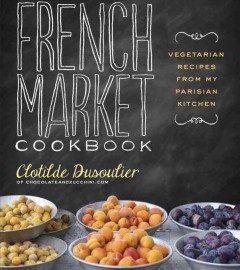
Bibliobites in January: Just Say “Non!”
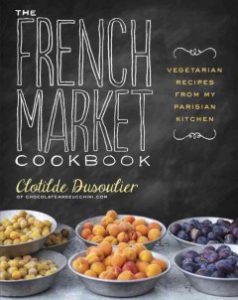 French cooking has (despite Julia Child’s efforts) a reputation for being complicated, fussy, and maybe a bit pretentious. It’s a cuisine famed for its reliance on butter, cream, and rich sauces. Traditionally it’s a meat-centric cuisine as well, with vegetables being little more than an afterthought. Well-known food blogger Clotilde Dusoulier, author of the January Bibliobites selection, aims to show us that modern French cooking is also vegetarian and straightforward. With the excesses of the holidays behind us, this book would seem to be the perfect way to welcome in a new year of healthier eating based on grains, legumes, and seasonal produce. As always, the group had strong opinions about their experience at the French Market.
French cooking has (despite Julia Child’s efforts) a reputation for being complicated, fussy, and maybe a bit pretentious. It’s a cuisine famed for its reliance on butter, cream, and rich sauces. Traditionally it’s a meat-centric cuisine as well, with vegetables being little more than an afterthought. Well-known food blogger Clotilde Dusoulier, author of the January Bibliobites selection, aims to show us that modern French cooking is also vegetarian and straightforward. With the excesses of the holidays behind us, this book would seem to be the perfect way to welcome in a new year of healthier eating based on grains, legumes, and seasonal produce. As always, the group had strong opinions about their experience at the French Market.
……And those opinions were strongly negative! There wasn’t a person at the meeting who enjoyed the book, with most actively disliking it. More than a few people wound up making none of the recipes. The most common complaints were that “nothing called to me,” and that the author frequently used ingredients that are difficult to find in the U.S. (the author is French but has lived in the U.S. and the book is written for an American audience). Par example, she uses spelt berries, rolled barley, lemon verbena leaves, chestnut flour, and celery root, all of which are not readily available. Another common criticism was that the recipes are on the bland side and/or have odd (or should we say unusual?) spicing. For instance, the only flavor in the otherwise very neutral lentil croquettes was a teaspoon of coriander, which was overpowering, with nothing else to balance it out.
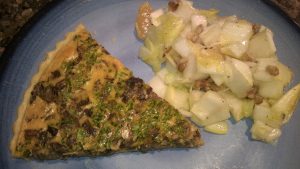
Other recipes that we tried included the cauliflower gratin with turmeric and hazelnuts, which was good but used enough turmeric to make the sauce “neon”! The couscous with vegetables was ordinary, with a few people commenting that they already had similar, and better, recipes for this dish. The softly spiced carrot and almond soup tasted very strongly of cardamom and anise but still seemed like it was missing something; and the butternut and celery root soup was “OK but not outstanding– and I have other squash soup recipes that I like better.” The blanch-roasted new potatoes were a two-step process, as the name implies, but the difference in taste or texture was negligible, and therefore not worth the extra effort. The mushroom and chive quiche was heavy on the mushrooms, which made it unexpectedly expensive; it tasted good but didn’t have that smooth custardy texture we were looking for. The above- mentioned lentil croquettes also lost points for being a bit tricky to assemble; the lentils had little to bind them and tended to fall apart. The tahini sauce that accompanied them was delicious, though.
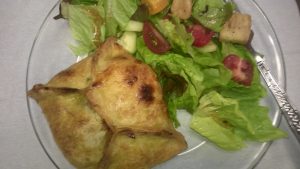
Some of the more successful recipes (in our opinion) included savory pumpkin and cornmeal quick bread, leeks vinaigrette, and endive, orange, and walnut salad. The green bean, red rice, and almond salad, was “good– but I used brown rice because I had it;” the goat cheese and rosemary sables were tasty but the texture was unexpectedly soft– “I wish they were crunchier, more like crackers.” The Corsican turnovers with winter squash were “good but not great,” though they scored points for cuteness and portability.
The book itself, also came in for some critical comments: the format was too small for most people, and there weren’t enough photos. Some of the recipes had unnecessary steps, or it was unclear why those steps were needed. But of course these complaints would have disappeared had everyone enjoyed the food! So, nous sommes désolés (we’re sorry) Clotilde– as far as we’re concerned your book just doesn’t make the grade; our vote yielded an average of 1.625 chef’s hats (out of a possible 5). Mon Dieu!
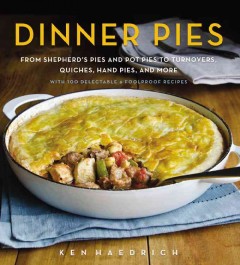 Join us when we meet again on Friday, February 24 at 11 AM in the Fireplace Room. This month’s title is Dinner Pies by Ken Haedrich. You still have a week to try out recipes! Copies are available at the main desk.
Join us when we meet again on Friday, February 24 at 11 AM in the Fireplace Room. This month’s title is Dinner Pies by Ken Haedrich. You still have a week to try out recipes! Copies are available at the main desk.
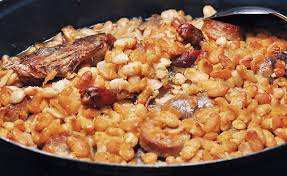
Qu’est-ce que c’est?
 Every year in January, after the rush of the holidays is over and we settle into some real winter, I spend a day making cassoulet. This iconic French dish is a hearty casserole of meat, beans, and some token vegetables, cooked with wine and tomatoes and topped with buttery croutons. It’s the perfect antidote to a raw winter day, and like many stews tastes even better left over. But it is kind of an all-day affair; beans must be soaked, meats must be cut up and browned, and then everything is assembled and baked. I usually use a recipe from the Cook’s Illustrated website, which mostly uses common ingredients we can find in any supermarket.
Every year in January, after the rush of the holidays is over and we settle into some real winter, I spend a day making cassoulet. This iconic French dish is a hearty casserole of meat, beans, and some token vegetables, cooked with wine and tomatoes and topped with buttery croutons. It’s the perfect antidote to a raw winter day, and like many stews tastes even better left over. But it is kind of an all-day affair; beans must be soaked, meats must be cut up and browned, and then everything is assembled and baked. I usually use a recipe from the Cook’s Illustrated website, which mostly uses common ingredients we can find in any supermarket.
HOWEVER…while most large supermarkets now carry an astonishing array of Asian, Italian, or Middle Eastern ingredients, French-specific items seem to have fallen by the wayside—if they were ever available in the first place. Par example, every year I go on a quest to find the beans traditionally used in cassoulet, which are called flageolet.  They are smallish, oval, pale-green beans that I’ve discovered can be difficult to find locally (yes I know I can order them on Amazon, but what fun is that?). The readily-available Great Northern bean is a passable substitute, but hey—if I’m only doing this once a year I want to be authentic about it. In past years I’ve seen flageolet at Whole Foods but no luck this year. Market Basket, Hannaford, and Wegmans were also a no-go. Finally I remembered that Idylwilde Farms in Acton carries some less-common grocery items, and—yes! There they were, sitting placidly on the shelf with all the other dried beans. Interestingly enough they were grown in Maine!
They are smallish, oval, pale-green beans that I’ve discovered can be difficult to find locally (yes I know I can order them on Amazon, but what fun is that?). The readily-available Great Northern bean is a passable substitute, but hey—if I’m only doing this once a year I want to be authentic about it. In past years I’ve seen flageolet at Whole Foods but no luck this year. Market Basket, Hannaford, and Wegmans were also a no-go. Finally I remembered that Idylwilde Farms in Acton carries some less-common grocery items, and—yes! There they were, sitting placidly on the shelf with all the other dried beans. Interestingly enough they were grown in Maine!
Another traditional ingredient used in cassoulet, which seems to be on every bistro menu in France but is rarely seen here, is duck confit.  This is a duck leg which has been cooked in and then covered with duck fat, a pre-refrigeration method of preserving meat. The confit can be eaten by itself or added to main-dish salads or casseroles, where it adds richness and flavor. But in the US this is definitely a specialty item; I did find it at Wegmans but c’est tres cher (it’s very expensive!). In my duck-buying expeditions I discovered that any form of duck, whether fresh, frozen, or otherwise preserved, is not widely sold in supermarkets. Whereas in France, again, it is on every restaurant menu in some form, and probably in every market as well. It’s a curious cultural difference!
This is a duck leg which has been cooked in and then covered with duck fat, a pre-refrigeration method of preserving meat. The confit can be eaten by itself or added to main-dish salads or casseroles, where it adds richness and flavor. But in the US this is definitely a specialty item; I did find it at Wegmans but c’est tres cher (it’s very expensive!). In my duck-buying expeditions I discovered that any form of duck, whether fresh, frozen, or otherwise preserved, is not widely sold in supermarkets. Whereas in France, again, it is on every restaurant menu in some form, and probably in every market as well. It’s a curious cultural difference!
So, flageolet—check! Duck confit—check! The cassoulet ingredients were cooked, assembled, and went into the oven. What to eat with it? A green salad immediately came to mind, but being in a “difficult French ingredient” mode I had decided to make celeri remoulade, a salad made of grated celeriac (or celery root).  Our Bibliobites book for this month, The French Market Cookbook by Clotilde Dusoulier, has a few recipes that use this root vegetable. So by now I know who sometimes carries it. It’s available in many supermarkets, but is ordered infrequently and in small quantity, so it’s hit-or-miss as to whether you’ll find it on any given visit. Again, this is a very common ingredient in France and all of northern Europe. I often wonder if celeriac will be the next cauliflower—that is, an ingredient which has been around forever, sort of in the background, and suddenly becomes a produce superstar. Celeriac is a knobby white root vegetable that looks sort of like a hairy turnip. It has a mild taste, celery-ish with hints of anise, and a texture similar to a turnip’s. Dusoulier’s book has a recipe for a potato/celeriac gratin which was delicious. The celery root lightens the dish a bit and adds a subtle, welcome flavor.
Our Bibliobites book for this month, The French Market Cookbook by Clotilde Dusoulier, has a few recipes that use this root vegetable. So by now I know who sometimes carries it. It’s available in many supermarkets, but is ordered infrequently and in small quantity, so it’s hit-or-miss as to whether you’ll find it on any given visit. Again, this is a very common ingredient in France and all of northern Europe. I often wonder if celeriac will be the next cauliflower—that is, an ingredient which has been around forever, sort of in the background, and suddenly becomes a produce superstar. Celeriac is a knobby white root vegetable that looks sort of like a hairy turnip. It has a mild taste, celery-ish with hints of anise, and a texture similar to a turnip’s. Dusoulier’s book has a recipe for a potato/celeriac gratin which was delicious. The celery root lightens the dish a bit and adds a subtle, welcome flavor.
As for my salad, predictably enough, the day I needed the celeriac there was none to be found on the shelf at Wegmans. C’est la vie! I wasn’t in the mood to hunt it down elsewhere so we enjoyed our cassoulet with a green salad after all. It was delicious, if I do say so myself; so as Julia Child would say—Bon Appetit!
For those of you who belong to our Bibliobites group, have you been enjoying your French Market adventure? Whether oui or non, please join us for our next Bibliobites meeting on Friday, January 27 at 11 AM in the Fireplace Room.
For those of you who have yet to discover our cookbook group, ce n’est pas grave! — we meet the last Friday of every month. Join us!

I’ve Never Been to Italy…..
 …..but I have been to Eataly! This gastronomic temple of all things Italian opened in Boston two weeks ago. It’s the newest outpost of this global enterprise, and one of only four in the US. I’d been to Eataly in Manhattan and was excited to check out our local store, located in the Prudential Center. All in the name of BiblioBites research, of course; inquiring minds always want to know about the latest new thing in the Boston food scene!
…..but I have been to Eataly! This gastronomic temple of all things Italian opened in Boston two weeks ago. It’s the newest outpost of this global enterprise, and one of only four in the US. I’d been to Eataly in Manhattan and was excited to check out our local store, located in the Prudential Center. All in the name of BiblioBites research, of course; inquiring minds always want to know about the latest new thing in the Boston food scene!
Eataly was conceptualized and founded in Torino, Italy in 2007 by Oscar Farinetti, who wanted to make top-quality Italian food accessible to all in a European open-market style. His main collaborators in this enterprise are celebrity chefs Mario Batali and Lidia Bastianich, who shepherded the opening of the Boston store. (Check out their latest titles: Batali’s Mario Batali Big American Cookbook; Bastianich’s Lidia’s Mastering the Art of Italian Cuisine). One of Eataly’s prime directives is “eat, shop, learn,” and certainly it’s easy enough to do all three on any given visit.
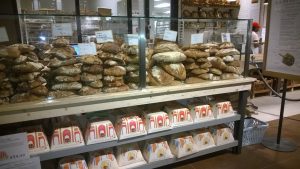 The Boston store is about half the size of the NYC store, but this is a good thing! It’s much less overwhelming, though the aisles are maze-like and can be difficult to negotiate when it’s crowded. Shelves of specialty items are crammed next to cases laden with cheese, salami, fresh pasta, foccaccia, gelato, and more. If you want a snack there are two espresso bars, a cannoli cart (unique to the Boston store), pastry counter, and a crepe stand. And should you need lunch or dinner, fear not. You have multiple options for takeout and sit-down meals. For the latter, there’s La Pesce for fish, La Pizza e la Pasta for– pizza and pasta, and in the center of it all, La Piazza, a bar-like area serving drinks and small plates. For takeout there’s an area devoted to salads hot and cold, vegetables, risotto, roasted meats….it goes on! Takeout pizza is coming soon, as is a more formal restaurant on the third floor.
The Boston store is about half the size of the NYC store, but this is a good thing! It’s much less overwhelming, though the aisles are maze-like and can be difficult to negotiate when it’s crowded. Shelves of specialty items are crammed next to cases laden with cheese, salami, fresh pasta, foccaccia, gelato, and more. If you want a snack there are two espresso bars, a cannoli cart (unique to the Boston store), pastry counter, and a crepe stand. And should you need lunch or dinner, fear not. You have multiple options for takeout and sit-down meals. For the latter, there’s La Pesce for fish, La Pizza e la Pasta for– pizza and pasta, and in the center of it all, La Piazza, a bar-like area serving drinks and small plates. For takeout there’s an area devoted to salads hot and cold, vegetables, risotto, roasted meats….it goes on! Takeout pizza is coming soon, as is a more formal restaurant on the third floor.
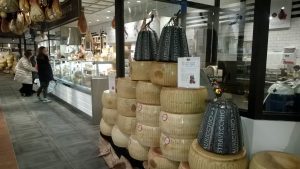 While there I lunched on a prosciutto, fresh mozzarella, and arugula panini. One of the stated goals of Eataly is to source and sell high-quality ingredients, and the panini certainly illustrated that; the prosciutto was tender and not too salty, the mozzarella fresh and milky, and the bread toothsome and flavorful. To go with my sandwich, there were house-made ultra-thin potato chips, which were so perfectly light and salty (think Lays on steroids) that I couldn’t stop eating them. I tried coffee at both of the espresso bars– Lavazza and Illy– I preferred the Illy. The coffee was surprisingly, screamingly hot, which I wasn’t expecting. After I got over the shock, I did appreciate it, since I usually think that most coffee isn’t hot enough.
While there I lunched on a prosciutto, fresh mozzarella, and arugula panini. One of the stated goals of Eataly is to source and sell high-quality ingredients, and the panini certainly illustrated that; the prosciutto was tender and not too salty, the mozzarella fresh and milky, and the bread toothsome and flavorful. To go with my sandwich, there were house-made ultra-thin potato chips, which were so perfectly light and salty (think Lays on steroids) that I couldn’t stop eating them. I tried coffee at both of the espresso bars– Lavazza and Illy– I preferred the Illy. The coffee was surprisingly, screamingly hot, which I wasn’t expecting. After I got over the shock, I did appreciate it, since I usually think that most coffee isn’t hot enough.
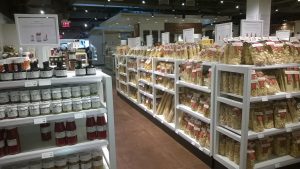 One of Italy’s main claims to culinary fame is its endless variety of pasta, and here Eataly does not disappoint. There are at least twelve brands of dried pasta represented, from artisan varieties costing $7 or $8 per pound, to the familiar blue-boxed Barilla. Pasta is sold in every conceivable shape; whole-wheat and other flours are also represented. To go with your pasta there are several types of jarred sauce (tomato-based or pesto) and multitudinous varieties of olive oil.
One of Italy’s main claims to culinary fame is its endless variety of pasta, and here Eataly does not disappoint. There are at least twelve brands of dried pasta represented, from artisan varieties costing $7 or $8 per pound, to the familiar blue-boxed Barilla. Pasta is sold in every conceivable shape; whole-wheat and other flours are also represented. To go with your pasta there are several types of jarred sauce (tomato-based or pesto) and multitudinous varieties of olive oil.
If you’re not in the mood for pasta (is that possible?), there are ten or so kinds of risotto, and at least four styles of polenta. Or, if it’s appetizers you need, in addition to the aforementioned cheese and salami there are olives galore, semi-dried tomatoes, breadsticks, and pickles of various sorts. And don’t forget the sweets: chocolates, cookies, and (since it’s Christmastime), several varieties of panettone.
After wandering about for an hour or so, I was on sensory overload, and managed to miss the wine shop. Next time! There’s also La Scuola, where you can take a food or wine class. In viewing the schedule, classes range in price from $10 to $150, but the vast majority are sold out through the end of February, the latest date shown online.
If you love Italian food, Eataly is absolutely worth the trip, but choose your day and time carefully! My first visit was on a weekday morning; I arrived around 9:45 AM and pretty much had the place to myself, as you can see from the photos. By 11 AM or so things were hopping and it was difficult to move in some of the aisles. Lunch around noon entailed a wait, but it was only about 5 minutes. However by 12:30 the lines were considerably longer. On a second brief visit on a Saturday evening, it was so crowded I could barely walk anywhere. The line for panini stretched outside the store, and all the other stations were similarly busy. Eventually the novelty will wear off and the crowds thin out, but for now I’d advise a weekday expedition; and remember to bring your patience. One oddity of Eataly’s layout is that you pay for any fresh food at the counter where you buy it, but boxed and jarred items are paid for at a set of registers near the exit. So depending on what you buy, you could wind up standing in several lines before you finally emerge with your bounty!

Bibliobites in December: Baker’s Dozen
Our combined November/December Bibliobites meeting on December 2nd covered numerous topics, in addition to discussing this month’s titles. Something about the subject of cookies, and taste-testing brownies (more on that in a moment!) seemed to bring out lots of opinions about baking, cookbooks, and more. It was a lively and enjoyable discussion!
Our first order of business was a “Brownie Smackdown.” Although this is a group that loves to cook, occasionally even we may resort to a mix of one sort or another. Brownie mixes are ubiquitous and come in so many varieties– are there any that can come close to homemade? We tried four brands: Betty Crocker, Duncan Heinz, Ghirardelli and Pillsbury Purely Simple. All were a basic dark chocolate variety (no frosting, or extra fudge) baked according to package directions, and no one tasting them knew which was which. Group members ranked them from one to four, with one being the best. So the lower the overall score, the better. Our final tally:
- Betty Crocker: 15 points
- Pillsbury Purely Simple: 18 points
- Ghirardelli: 20 points
- Duncan Heinz: 27 points
Both the Betty Crocker and the Pillsbury were less familiar to the group overall (that is, fewer people had tried them); and, as is the case with most food items, people had strong preferences which influenced their ratings. There’s always the fudgy vs. cakey camp, for one; also soft vs. chewy and bold chocolate flavor vs. more subtle. Duncan Heinz had the least chocolate flavor, with more than one person commenting that they had no chocolate flavor at all! They were also deemed too soft and wet. So, sorry Duncan Heinz– you’re at the bottom of the pack. The other three were definitely tastier and more chocolatey, and each had its advocate. Would we buy these instead of making homemade? Most insisted that brownies are so easy to make from scratch that there’s no reason to ever buy a mix, especially when homemade tastes better. A mix can be handy on a day when you’re pressed for time and don’t want to think about pulling out ingredients, but this group wasn’t totally convinced that it was worth it.
As a side note, after the tasting we wondered if the order in which the products were tasted influenced how they were rated. Interestingly, the Betty Crocker was the first one most tried– and that came out on top. Later a few of us tried some of the brownies in different order, and it always seemed like the first one had the best chocolate flavor (except for Duncan Heinz– sorry DH!). So OK, we’re not pros at the taste-testing game (maybe next time we should spit and rinse, like a wine tasting?), but we learned a little and got to eat some brownies, too. Readers, have you used a mix that you think is as good as a from-scratch product? Let us know and we’ll publish a list.
Some people commented that brownies were one of the first things they learned to bake, and that sparked a discussion of cookbooks used when we were growing up. Many had fond memories of Betty Crocker’s Cook Book For Boys and Girls, 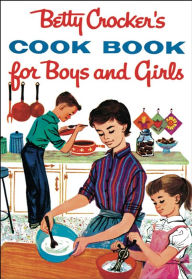 initially published in 1957. From there we wondered what was everyone’s “go-to” cookbook– what do you consult when you want information and/or a foolproof recipe? Unsurprisingly, the internet received plenty of votes; but one’s own family recipe box was also mentioned by several people. Other Betty Crocker titles, books published by Good Housekeeping, and America’s Test Kitchen Best Recipe were praised as well. As with so much else related to cooking, it’s a highly personal choice!
initially published in 1957. From there we wondered what was everyone’s “go-to” cookbook– what do you consult when you want information and/or a foolproof recipe? Unsurprisingly, the internet received plenty of votes; but one’s own family recipe box was also mentioned by several people. Other Betty Crocker titles, books published by Good Housekeeping, and America’s Test Kitchen Best Recipe were praised as well. As with so much else related to cooking, it’s a highly personal choice!
Moving on to our cookie discussion, it seemed there was a lot of recipe reading that went on, but not so much baking. We enjoyed perusing both books and at least marking recipes we wanted to try— later! I did ultimately bake the vegan ginger cookies and the date-fig nut bites from Crazy About Cookies— and both were excellent. The ginger cookies were soft and chewy with plenty of spice, and the date-fig cookies were cakey and fruity; kind a high-class Fig Newton. From Chewy Gooey Crispy Crunchy, one person made the ultra-thin chocolate chip cookies, which were crispy yet sturdy, with classic chocolate-chip cookie flavor. Another praised the French macarons recipe, which had lots of specific information that ensured success. Author Alice Medrich, well-known for her multiple chocolate-themed cookbooks, includes many helpful general tips, such as always resting your cookie dough in the fridge before baking. She also provides ideas for you to go beyond her basic recipe and make it your own.
On the savory side of things, we also perused Martha Stewart’s Appetizers. As with the cookie books, there was more reading than doing! We really liked the layout of this book; each page had a recipe and several variations, with photos. It was clear and easy to read, and the book stayed open when laid on the counter. Complaints included a poor index, and too many recipes that required deep-frying. One person tried the pistachio-stuffed dates, which were delicious and led to a short discussion of all the yummy ways you could stuff a date! Another person enjoyed the kale and fontina stuffed mushrooms despite the sauce being a bit too thin for their liking. There was an “epic failure” with the roasted spiced chickpeas which just refused to become crisp. Other members had tried similar recipes with success, so we weren’t sure exactly what the problem was– possibly too much oil in the pan? In general, everyone had a favorable impression of this book; most of the recipes seemed appealingly easy and sounded, well, appetizing! It’s a user-friendly successor to Martha Stewart’s Hors D’oeuvres, which many remembered well from the 1980s.
Our cookie discussion at one point brought up hermits, an old-fashioned cookie that is certainly still enjoyed today. As always, there were definite opinions on what this cookie should contain (most include nuts, others don’t), and how it should be made (in a long bar that is cut into cookies after baking). Decades ago I clipped this recipe from the fondly-remembered Confidential Chat column in the Boston Globe. It was submitted by a contributor known as The Cantabridgian. They are delicious!
Hermits
3/4 to 1 cup shortening
1 1/2 cups sugar
1/2 cup molasses
2 beaten eggs
3 1/2 cups flour
1/2 to 3/4 cup chopped raisins
3/4 to 1 cup chopped walnuts
1 teaspoon salt
1/2 teaspoon baking soda
1 teaspoon cinnamon
1/2 teaspoon each: ground cloves, mace, ginger, nutmeg
Cream the shortening and sugar in a large bowl. Add molasses and eggs, then add flour slowly with all other dry ingredients. Add raisins and nuts and mix until combined. The batter will be stiff; if it seems dry add a little water.
Spread about 3 cups of batter on parchment or a greased cookie sheet. The batter should be a long, thin oblong about 1/2″ thick. (If you have a wide cookie sheet you can fit 2 oblongs on one sheet). Bake at 350 for 10-12 minutes, or until cookie tops almost spring back when pressed with a fingertip. Let cookies cool on sheet for 5-7 minutes, then cut across on the diagonal about 2 inches wide. Cool on rack; repeat process with remaining batter. Makes 4-5 dozen. Enjoy!
Whichever December holidays you celebrate, may they be filled with generous helpings of family, friends, and of course– fabulous food! We will meet again on Friday, January 27 at 11 AM in the Fireplace Room. To counteract all those holiday treats, we will be cooking lots of vegetables from Clotilde Dusoulier’s The French Market Cookbook. Copies are available at the front desk. Bon appetit!
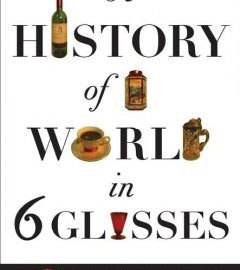
Bibliobites in October: We’ll Drink to That?
When you enjoy a glass of wine with your dinner, do you ever ponder its provenance? When you uncap a cold beer on a hot summer day, have you ever wondered how brewing got started? Many of us can’t imagine a day without that trio of caffeinated drinks: coffee, tea, and Coke; but where and when did they originate? We discovered this month that many common beverages have a long and checkered past. Since the beginnings of humanity, people have had to settle where there was water; but other drinks have also shaped history in prominent and surprising ways. This month’s title, A History of the World in 6 Glasses, views its namesake drinks through the lens of politics, culture, religion, and more.
If you’re thinking right now that this all seems pretty weighty for a cup of coffee or a Coke– our group would agree with that. While most found the history “interesting,” there was a bit too much information, particularly in the earlier chapters, which focus on beer and wine. We recognized that these drinks have centuries of history to explore, and author Tom Standage provides a detailed, almost academic treatise of his subject. Some felt his writing was just too dry for their taste (like some wines?), though we did enjoy the numerous anecdotes sprinkled throughout. Here’s one factoid to mention at your next workshop or conference: the word symposium comes from the Greek symposion, which means a ritual drinking party/discussion group with a “formal, intellectual atmosphere.” Since Greeks watered their wine (they thought this was the civilized way to drink), they were probably able to speak coherently for most of the evening. But do remember that a symposium, by definition, includes wine!
Things picked up a bit in the chapter on spirits, which have a considerably shorter history. Rum in particular played a big part in Colonial America’s economy, mostly because of the molasses-rum-slaves triangle you may remember from high school social studies class. Whiskey also became popular in this period, as it could be produced from crops grown domestically; and a still was easily constructed. Spirits played a prominent role in election campaigns, as well; imagine if the following happened today: “When George Washington ran for election in 1758 to Virginia’s local assembly, the House of Burgesses, his campaign team handed out twenty-eight gallons of rum, fifty gallons of rum punch, thirty-four of wine, forty-six of beer, and two of cider– in a county with only 391 voters” (Standage, p. 118). I’m pretty sure he won that race!
Moving on to the caffeinated three– coffee, tea, and Coca-Cola– the most popular chapter by far was the one about Coke. Somehow this section seemed the most entertaining and relatable; compared to the other beverages in the book, Coke has a very short history and most of us are familiar with parts of it already. Whether you like or despise Coke, its influence on our culture and economy are undeniable; and Standage vividly illustrates its global reach as well. Perhaps part of the intrigue and enjoyment of this chapter came from understanding the history of something so ubiquitous that we rarely think about its whys and wherefores.
Both coffee and tea share this trait; that is, they’re so common and consumed by so many people that for us they just are. Like wine and beer, they have a long history across many nations, and like Coke they have had an outsize influence on politics, national economies, and culture. Again, most members of the group thought these chapters were “interesting,” but felt a little overloaded by the sheer volume of information. We enjoyed the discussion of how coffee fueled the early Industrial Revolution; instead of drinking beer or cider before work, people started to drink coffee and were therefore more alert on the job. Undoubtedly safer for all concerned! Coffeehouses were also extremely popular as meeting places/de facto offices going back to the early 18th century, so Starbucks definitely didn’t invent that idea. But sorry, ladies– coffeehouses were only for men. No lattes for you!
Tea was drunk in China for centuries before the British discovered it; but the UK’s near-universal adoption of this beverage had far-reaching consequences for both China and India, and of course for the American colonies. Our group was surprised to learn of tea’s role in the 19th century opium trade (yes, there was a not-so-secret opium trade with China endorsed by the British government!), but no one needed to be reminded of the role tea played in the beginnings of the American Revolution
Standage ably proves his point– that “…drinks have had a closer connection to the flow of history than is generally acknowledged, and a greater influence on its course.” (Standage, p.5). While our group acknowledged that this book was a worthwhile read, for most it just wasn’t their cup of tea (so to speak). This was reflected in our voting, where this title received and average vote of 2.1 chef’s hats. However, if you enjoy history, and delving into a subject at length, then this book may be just what you’re looking for.
Our next meeting will be Friday, December 2 at 11 AM in the Fireplace Room. Please note that this is a combined November/December meeting. All are welcome! This month’s titles are about “savories and sweets”: choose Martha Stewart’s Appetizers, by Martha Stewart; or Chewy Gooey Crispy Crunchy: Melt-in-your-mouth Cookies by Alice Medrich; or Crazy About Cookies: 300 Scrumptious Recipes for Every Occasion & Craving by Krystina Castella. Copies are available at the main desk.
At our last meeting, we voted on whether to have a cookie swap at the December meeting; the result was we will not have the swap. But, since it is our holiday meeting, how about a recipe grab-bag? Bring a favorite recipe (holiday or otherwise, sweet or savory), and we’ll put them all in a box, and everyone can draw one to take home and try. You can fold it up, roll it, or put it in an envelope– please feel free to get creative with your packaging. As always, this activity is optional.
May you all enjoy a bountiful Thanksgiving, and see you December 2nd!

Bibliobites: Barefoot in the Kitchen
The popular and prolific Barefoot Contessa, a.k.a Ina Garten, was on tap for the first meeting after our summer break. Garten has several titles published over the past ten or twelve years, and the one we chose is How Easy Is That? In general there was a lot of enthusiasm for this cookbook; recipes were often familiar, but with an interesting, flavorful twist. And many were, in fact, quite easy!
The size and shape of this book made it a pleasure to use; pages stayed open on the counter and every recipe was accompanied by a luscious photograph. Many recipes were on one page, which eliminates tedious flipping; and even most that were on two pages were on two facing pages, again avoiding that annoying back-and-forth. This may be a small detail, but it’s much appreciated by a cook with messy hands! All of Garten’s cookbooks have this same format, so it’s obvious she and her publisher have worked to develop a layout that is both practical and pretty.
But let’s get into the kitchen and see what we cooked up! Starting at the beginning, the roasted figs & prosciutto were quick to make and delicious; but most people focused on the main dishes and sides. Jeffrey’s roast chicken was “really good,” as was the panko-crusted salmon. However the roasted salmon with green herbs didn’t work out so well; the fresh herbs burned in the hot (425 degree) oven and were charred instead of the pretty green shown in the photo. Warm French lentils were deliciously mustard-y; the spicy turkey meatballs & spaghetti were good, but not a whole lot better than any other meatball. The rich beef barley soup used a less-common ingredient, oxtails, to boost the beefy flavor. This technique did work; but the oxtails were not inexpensive, as the recipe’s headnote claimed– and so that recipe isn’t a keeper! The lobster & shells pasta salad was flavorful with lemon and dill, while the easy Parmesan risotto was a snap to make in the oven, and a good introduction to a dish often avoided because of its typically fussy stovetop preparation. Other side dishes we liked were the garlic-roasted cauliflower (“very tasty, but it became blah after a couple of days in the fridge”), the scalloped tomatoes (“so good!”), and the tomatoes roasted with pesto (ditto– is there a trend here?). But, the roasted butternut squash did not live up to expectations; it was just plain old cooked squash! In the dessert category, the easy cranberry & apple cake was tender, fruity, and delicious (I can personally attest to this!), and the fresh peach cake was equally enjoyable.
There were a few quirks that we noticed. Many recipes called for what seemed like an excessive amount of salt, though certainly this is easily adjusted. We wished that some recipes gave alternate measurements, for instance, how much breadcrumbs result from “3 cups of cubed bread”? What is the weight of 1/2 cup of grated cheese (in order to know how much to buy)? Garten also repeatedly lists “good” olive oil as an ingredient. What other type would anyone use?? A few people complained that, despite assertions to the contrary in the introduction, they had to buy specialty ingredients that they only used a bit of, and were then stuck finding another use for.
These were minor quibbles, though, and most people thoroughly enjoyed their journey through Contessa-land. This was reflected in the voting, where most gave it the top rating: 5 chef’s hats. And for Barefoot Contessa devotees, she has a new book coming out on October 25: Cooking for Jeffrey: A Barefoot Contessa Cookbook.
Our next meeting will be on Friday October 28 at 11 AM in the Fireplace Room. This month’s title is A History of the World in 6 Glasses by Tom Standage. All are welcome to join us!
Aquafaba….It’s Egg-cellent!
 One day, while wasting time on the internet and checking out various food blogs, I came across a term I’d never seen before: aquafaba. A quick Google search turned up this article from the NY Times, as well as an “official” aquafaba site (who knew an ingredient could have its own PR?). But…what the heck is it, and why is it suddenly all over the blogosphere?
One day, while wasting time on the internet and checking out various food blogs, I came across a term I’d never seen before: aquafaba. A quick Google search turned up this article from the NY Times, as well as an “official” aquafaba site (who knew an ingredient could have its own PR?). But…what the heck is it, and why is it suddenly all over the blogosphere?
Well, if you’re a vegan (I’m not), one of the trickier things to do is to bake reliably without eggs, and I can see that it would be difficult to replace the emulsifying and leavening properties of eggs, particularly in cakes (and let’s not even get started on, say, meringues!). There are numerous acceptable substitutes for milk, but the egg thing has always been a bit of a stumbling block…until now. Apparently, if you drain a can of chickpeas, and take that liquid that you normally toss out, and dump it in your mixer and whip it for about 5 minutes, you have what looks, acts, and tastes like whipped egg whites.

This concept was just so weird to me, and I didn’t believe it would work, so of course I had to try it. Guess what? It really DOES work. OK, so it smells and tastes faintly beany, but once you add other dessert-friendly ingredients like sugar or chocolate, the aquafaba is indistinguishable from egg whites.
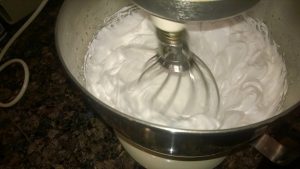 The first thing I tried with it was a chocolate mousse, since the recipe seemed to be on every aquafaba-related website I visited. Sure enough, it tasted only like chocolate mousse, and had that nice, fluffy texture as well.
The first thing I tried with it was a chocolate mousse, since the recipe seemed to be on every aquafaba-related website I visited. Sure enough, it tasted only like chocolate mousse, and had that nice, fluffy texture as well.
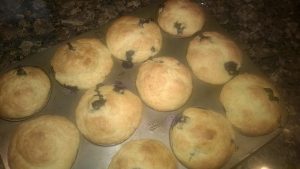 Next I tried a vegan blueberry muffin recipe which also worked quite well. Then, last night I baked a giant meringue which I plan to use to make Eton Mess, a classic British dessert in which meringue is one of the main ingredients. Sadly, aquafaba meringue reacts the same way to humidity as does the egg-white variety, and I now have a somewhat sticky meringue which I will attempt to dry out in a very low oven. But it’s all good since I’m using up something I would ordinarily have tossed. Now I have the opposite problem: what to do with all those chickpeas that I drained! But since it’s summer, how about a salad? This recipe is a great main dish for a steamy day: open a few cans, mix, chill, and eat! Leftovers are tasty, too.
Next I tried a vegan blueberry muffin recipe which also worked quite well. Then, last night I baked a giant meringue which I plan to use to make Eton Mess, a classic British dessert in which meringue is one of the main ingredients. Sadly, aquafaba meringue reacts the same way to humidity as does the egg-white variety, and I now have a somewhat sticky meringue which I will attempt to dry out in a very low oven. But it’s all good since I’m using up something I would ordinarily have tossed. Now I have the opposite problem: what to do with all those chickpeas that I drained! But since it’s summer, how about a salad? This recipe is a great main dish for a steamy day: open a few cans, mix, chill, and eat! Leftovers are tasty, too.
Castilian Salad
1 6-oz can tuna, drained (you can use oil- or water-packed as you prefer)
1 15-oz can chickpeas, drained
1 15-oz can artichoke hearts, drained and quartered
1 cup thinly sliced celery
1/2 cup pimiento-stuffed green olives, halved
2/3 cup creamy Italian dressing mixed with 1 garlic clove, minced
Combine all ingredients in a large bowl. Pour dressing over and mix well. Garnish with wedges of tomato and hard-cooked eggs, if desired. Serve on lettuce leaves if you are feeling fancy.
********************************************************
Interested in reading, cooking and eating? Our Bibliobites Cookbook group returns on September 30th, check it out!
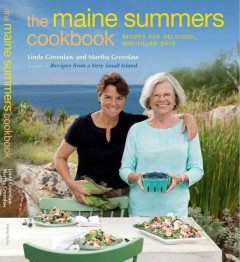
Bibliobites in June: A Maine Event
Summer was knocking on the door as we met at the end of June to discuss The Maine Summers Cookbook by Linda Greenlaw and Martha Greenlaw. Linda, a swordfish-boat captain made famous in Sebastian Junger’s The Perfect Storm, is an accomplished author in her own right, with mysteries, memoirs, nonfiction, and cookbooks to her credit. Logically enough, this title focuses on what we think of as classic New England summer fare– anything grilled; lots of seafood; salads and veggies fresh from the garden; and tried-and-true desserts like pie and ice cream. Ms. Greenlaw’s affection for Maine and for Isle au Haut (her family’s summer home) in particular is evident throughout the book, as is her passion for locally grown and produced food. The stories in many of the recipes’ headnotes give the reader a real feel for the island community, and the scenic photography provides an (almost!) “you are there” experience.
But with a cookbook, it’s really all about the recipes, and we made plenty! A thumbs-up was given to the Maine shrimp gazpacho; and the Moxie Island baked steak was “tasty.” The grilled turkey burgers with tomato-mango chutney were good, though nothing out of the ordinary, and the chutney was liquidy and refused to stay on the burger. The sweet corn salsa was a delicious, less messy accompaniment. Many recipes utilized shrimp: one member loved both the baked shrimp with garlic-basil butter and Patty’s buttery stuffed shrimp. Maine shrimp risotto was good, but even better after mellowing for a day or two in the fridge. Two people tried the tomato, caramelized onion, and brie galette, which had a delicious combination of flavors. The dough for the galette is piecrust, which seemed too rich with the cheese– pizza dough might make a better base. The eggplant fritters were a bit problematic– the patties were too wet despite roasting and then draining the eggplant. But the chunky chickpea salsa was a winner.
As for baked goods and desserts, the ginger-bran blueberry muffins were “excellent!”, and the old-fashioned peanut butter cookies were enjoyed by all at the meeting (thank you, Linda). The cinnamon-blueberry ice cream sounded tantalizing, but required 12 egg yolks for the recipe, which seemed a bit excessive; so no one actually made it!
Several people tried side dishes; among the favorites were the rosemary-balsamic roasted red potatoes; roasted new potato salad (“loved the tarragon!”); corn pudding with fresh basil; salad of tomato, feta, and basil; oven-roasted summer squash; and baby peas with mustard, horseradish, and butter.
The overall consensus was that the book fell short of awesomeness. People mostly liked what they tried, but they weren’t jumping up and down about it. Maybe we weren’t quite in summer cooking mode yet? There were some complaints about incomplete or incorrect instructions for some of the recipes, or ingredient proportions (see eggplant fritters above!). This led to speculation that the authors did not thoroughly test the recipes, or possibly didn’t even test them themselves. And editing could certainly have been better: for instance, the coconut panko cod recipe has backwards instructions for breading the fish. Some didn’t care for this title’s memoir-within-a-cookbook format, which seems to have become so popular; that is, cookbooks which have extensive stories and/or travelogues along with their recipes.But while most of us were pretty lukewarm about this title, one person loved it so much she was planning to buy it. She thought it was the perfect summer cookbook– so for her it was a welcome discovery. So when it came down to a vote, our likes and dislikes perfectly averaged themselves out, to leave us with a rating of: ![]()
![]()
![]()
Bibliobites will not meet in July and August, but we hope you’ll have lots of summer cooking adventures! Email us photos of your successes and flops, and we’ll publish them in a future post. Our next meeting will be on Friday September 30 at 11 AM in the Fireplace Room, title TBA.

Delicious Meets Healthy! – Bibliobites in May
Do I eat “healthy,” or do I choose what I really want? Do I have that yummy dessert with a million calories, or that boring old fruit salad? Pepperoni pizza for lunch, or a virtuous bowl of greens with oil-free dressing? Burgers and beer at a barbecue, or grilled chicken breast and seltzer water? These and countless other choices plainly illustrate the yin and yang of American eating– the idea that, if it tastes good it’s not good for you, and if it’s good for you, it’s boring and flavorless. This month’s title, Ellie Krieger’s The Food You Crave: Luscious Recipes for a Healthy Life aims to sweep away that uncomfortable dichotomy with recipes both healthy and delicious. Does she succeed? Let’s get straight to it:
First, people enjoyed the design of the book; its larger format meant most recipes could fit on one page, and there were plenty of gorgeous photos. And it stayed open by itself, always a big plus. The contents run the gamut from appetizers to desserts, and Ms. Krieger provides complete nutrition information (she is a registered dietitian, after all). One downside I discovered while writing this post: the index is awful! Many recipes are inexplicably not listed by name, and other oddities abound.
As always, though, the recipes tell the tale, and the takeaway seemed to be that this was an eminently approachable book: more than 30 recipes were tested, and a few sounded intriguing enough that multiple people made them. Since life is uncertain, let’s eat dessert first: the mocha cake with mocha cream cheese frosting was personally tested by group members, and was praised for its deep chocolate taste. The triple chocolate cookies also had plenty of true chocolate flavor and were easy to make. In the breakfast department, the nutty granola was a huge hit, disappearing rapidly; the scrumptious scramble was….scrumptious, and the apple-pecan muffins were “fruity and not too sweet– delicious!”
But for most people, the main dishes were the big attraction: recipes people enjoyed included the macaroni and four cheeses (“the first day I thought the squash flavor was too much, but the next day it was better”), sloppy joes (“good but too much red pepper”), confetti chili, (“delicious! But next time I’ll use less corn”), Greek-style stuffed peppers (“really good, and Mr. Fussy liked them, too!”), steak tacos with cucumber-avocado salsa, baked shrimp with tomatoes and feta, teriyaki chicken thighs (“good and sticky”), peppercorn pork with wine sauce (“delicious and so easy”), fettucine Bolognese, balsamic chicken with baby spinach and couscous (“best thing I made; very quick and very tasty;” vs., “I didn’t like the spinach in it, and it wasn’t quick”), and salmon cakes with ginger-sesame sauce (“the cakes were just OK, but the sauce is delicious!”).
For some sides to go with those main dishes, how about honey-roasted sweet potatoes, dirty broccoli, roasted nutmeg cauliflower, zucchini Parmesan crisps (“very good and super-easy…family gobbled them down!”), and cornmeal-crusted ratatouille tart (“flavor was good…needed more veggies, crust was too hard”). Several people raved about the lemon chicken soup with orzo; to go with it you could try sweet and spicy grilled cheese sandwiches. If it’s too hot to cook, salads like grilled Thai beef salad (“so many great flavors!”), savory Chinese chicken salad (“fresh and crunchy…I really liked the fruit in it”), or chickpea and spinach salad with cumin dressing (“easy to make, and good”) can get you out of the kitchen in a hurry.
In general, the book was praised for having lots of flavorful (dare I say crave-able?) recipes using everyday ingredients. We appreciated that most recipes were fairly quick, and a few were amazingly speedy. Several people weren’t ready to return the book, as there were more recipes they were eager to try. A few group members decided they wanted to buy the book– what higher praise could there be? There were a few complaints, though: some recipes used small quantities of ingredients that you might have trouble using up; for example, one recipe calls for 1/4 cup evaporated milk, another uses 3 sheets of phyllo dough (after you’ve defrosted the entire box to remove what you need!). A few people wished for menu suggestions– ideas on what to serve with what.
So does Ellie Krieger deliver on her promise of good and good for you? In the opinion of the group, definitely yes! Overall verdict: ![]()
![]()
![]()
![]()
Our next meeting will be on Friday, June 24 at 11 AM in the Fireplace Room. Our title this month is The Maine Summers Cookbook: Recipes for Delicious, Sun-Filled Days by Linda Greenlaw and Martha Greenlaw. Copies are available at the main desk. Our June meeting will also feature a cookbook swap! Bring one or more titles that you no longer want, and take home a “new” one to try out. Any extra books will be donated to the Friends book sale. See you then!
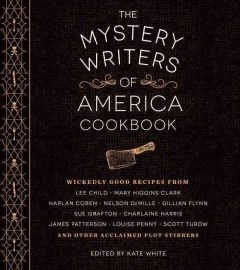
Bibliobites in April: Writers in the Kitchen
It’s no mystery that most of our Bibliobites members enjoy cooking; and many of us enjoy a good mystery novel as well. And it seems that, at least in the literary world, murder and mayhem often go hand in hand with culinary exploits of one sort or another. There are plenty of suspenseful books that feature a caterer, or a character who loves/hates to cook, or a detective who is known for his or her idiosyncratic eating habits (peanut butter and pickle sandwiches, anyone? See p. 67!). This month we read and cooked from The Mystery Writers of America Cookbook and it afforded us a unique opportunity to merge writers, their fictional characters, and some new recipes all at the same time.
First, the book itself: most of us liked the size of the book, with pages large enough that most recipes were only on one page. There were plenty of photos, too, though there was some doubt as to whether the pictures were of the actual recipes, as some didn’t seem to quite match up. Everyone appreciated that the book stayed open when using a particular recipe, and didn’t have that annoying habit of flopping closed just when you have messy hands.
For many, the best attribute of the book was the copious headnotes, which gave us some insight into the author’s thoughts about cooking in general, or the particular recipe, or what their character would have thought about it. It was fun to read these descriptions, which were by turns humorous, heartfelt, or surprising. It made for an enjoyable read, even if you didn’t want to cook anything, which was one of the reasons we thought this book would make a good gift. In addition, most of the recipes were on the quick side, and used ingredients that were easy to find. The book would also provide the mystery lover with a long list of books and authors to check out; many of us now have much longer reading lists!
But down to the nitty-gritty: what about the actual recipes? In general, people liked what they tried; among the favorites were the avgolemono soup (“loved it– healthy and easy!”), the chicken artichoke tarragon soup (“easy, flavorful, creamy without using cream, a keeper!”), Grand-mere Marie’s root vegetable vichyssoise (“really liked it, lends itself to ingredient substitution, will definitely make again!”). Also, the Italian chicken (“easy and flavorful”), spicy beans (“very good protein-centric non-meat meal”), spicy joes (“liked it very much, Greek and Turkish flavors– would probably be even better with lamb”), caramelized clay pot fish (“really delicious– quick and easy, and you don’t need a clay pot!”), chicken enchiladas (“as long as you don’t mind using a can of cream of chicken soup; good for a crowd”), shrimp scampi (“I had a great time with this recipe– it looked just like the photo and tasted great!”) Madame Benoit’s tourtiere (“so delicious– everyone loved it!”). A few people tried baking: the whole wheat wild blueberry lemon pecan muffins got a big thumbs-up; the killer chocolate cake was a winner (sans icing, which was “grainy”), and the Latvian solstice bars, which we got to sample at our meeting. These were “easy to make– very rich– the edges burned easily from all the sugar.”
On the negative side, Kathy’s Coke roast was “tender, but not very flavorful”; the spicy crock pot pork was “a little dry, and we didn’t care much for the flavor,” though another tester enjoyed it and didn’t feel it was dry. Neither thought it was terribly spicy! The world’s best red sauce wasn’t (“it was OK, a bit watery– wrong tomatoes?”); and the crab cakes had a “decent” taste but didn’t hold together well. (Others who love crab cakes suggested adding Old Bay seasoning, and refrigerating the mix before shaping the cakes to help them hold together better).
![]()
![]()
![]()
We instituted a rating system at our meeting, a scale of 1-5 chef hats, with 5 being the best. We all voted, and the average came out to 3.3; most members gave the book a 3 or a 4; no one awarded a 5. So, good but not great. Maybe those mystery writers should stick to writing!
Speaking of authors, a few cooking-related titles were recommended by group members. They included: Erica Bauermeister’s novel School of Essential Ingredients and Yes, Chef by Marcus Samuelsson. Check them out!
During our discussion, someone asked what was a good place to buy fresh fish. There seemed to be plenty of options; those who bought fish at Market Basket and Hannaford were quite satisfied with the quality. A bit further afield, Wegman’s and Whole Foods were praised, as was the frozen fish (especially the scallops) at Trader Joe’s. I put in my plug for Cape Ann Fresh Catch, which is a fish CSA that delivers day-boat fish from Gloucester to Jones Farm on Thursdays. Another mentioned the Chelmsford farmers’ market, which some weeks has a fish vendor. Living so close to the ocean, it seems we have lots of good choices!
Our next meeting will be Friday, May 27 at 11 AM in the Fireplace Room. Our title this month is The Food You Crave: Luscious Recipes For a Healthy Life by Ellie Krieger. Copies are available at the main desk. Happy cooking!





